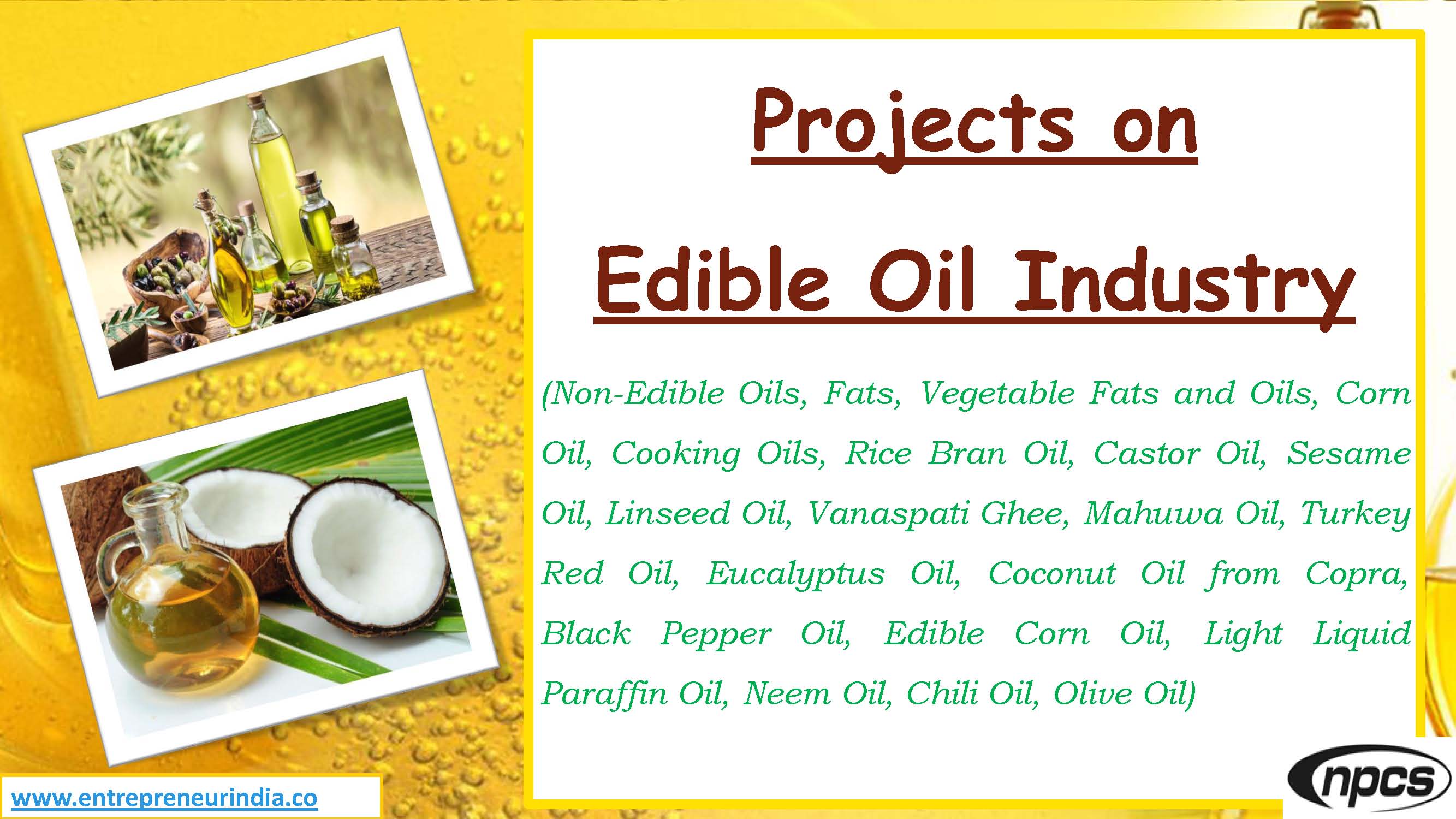Projects on Edible Oil Industry

Edible oils are most often plant-based oils, which are similar, if not the same as those produced by the industrial biotech industry for use as biofuels such as biodiesel, for use in cosmetics, and in other everyday biotech products. Edible oils may be solid or liquid at room temperature.
Mahuwa Oil
Mahuwa is a tropical fruit. It is found in the month of April – July or August – September. It is a fleshy green, yellowish or orange brown when ripe, 2.5 to 5 cm long, 1-4 shining seeds. It?s total mass content 70% in seed, two kernels in a seed. 2.5 cm X 1.75 cm, oil content 46% in latatolia and 55% in longitolia which are smaller in size. Mahuwa fruits are taken and decartified to get kernels & then it is treated in the ghani or expeller or solvent extraction plant to extract out oil from it.
Castor Oil & its Derivatives
Castor oil and its derivatives are products of good commercial significance with advancement and new innovation in the field or medicines and allied fields. The demand of these products increasing day by day and their popularity is increasing at a rapid pace.
Turkey Red Oil
Turkey red oil which are also known as sulphonated castor oil in the trade is the oldest textile finishing agent. This oil should contain the minimum of free sulphur trioxide. Turkey red oil is essentially an intimate mixture of pigments, oil varnishes, driers and frequently waxy or greasy compounds. The ink must possess suitable physical characteristics such as viscosity, length and stock on which it is to be used.
Eucalyptus Oil
Eucalyptus oil is obtained by the distillation of leaves and terminal branch lets of Eucalyptus globulies (Blue Gum Tree). The oils obtained by the steam distillation of leaves and terminal branches of various species are distinctive in character. Australia is the largest producer of eucalyptus oils. About two thirds of the world’s supply of medicinal oil and third of industrial oil come from that country. The oil is used mainly for medicinal purposes.
Coconut Oil from Copra
Coconut oil, also known as coconut butter, is a tropical oil with many applications. It is extracted from copra (derived from Malayalam word “kopra” which means dried coconut). Coconut oil constitutes seven percent of the total export income of the Philippines, the world’s largest exporter of the product. Coconut oil was developed as a commercial product by merchants in the South Seas and South Asia in the 1860s. Coconut oil is a fat consisting of about 90% saturated fat.
Vanaspati Ghee
The synthetic fats are known in India by different names such as Vanaspati, Dalda Ghee, and Hydrogenated Oil etc. Perhaps because vanaspati ghee is manufactured with vegetable oils and there is not much change in the components of vegetable oil after it has undergone the process of refining and hydrogenation, the name Vanaspati has been given to this refined oil.
Black Pepper Oil
The trade distinguishes between two principal types of pepper, viz., the black and the white both derived from the same plant piper nigrum L. (fam. Piperaceae), a climbing or trailing vine like shrub native to southern India. Black pepper is the dried whole unripe fruit of this plant. Pepper is one of the most important and oldest spices. Oil of pepper is valuable adjunct in the flavouring of sausages canned meats, soups, table sauces and certain beverages and liquors.
Edible Corn Oil
Edible corn oil is manufactured from maize, wheat and other corn’s beaving oil by solvent extraction process. Corn generally contains 3-6% oil in its total constituents. There are several stages required for the production of refined corn oil. In India there are few manufacturers of corn oil even it can be told there is no manufacturer. There is well oil technologist available in India who can supply the proper technology of corn oil extraction. There is environmental pollution problem arise which can be solved by proper treatment.
Light Liquid Paraffin Oil
Light Liquid Paraffin Oil IP is highly purified mixture of liquid saturated hydrocarbons obtained from petroleum and is highly paraffinic in nature. Light Liquid Paraffin oil is transparent, & free from fluorescence in day light. It is colourless, tasteless, and odourless when cold. Light liquid paraffin oil IP highly refined hydro-treated oil has excellent thermal & chemical stability, having high flash point & is soluble in Chloroform & solvent Ether.
Neem Oil
Azadirachta indica (Neem) tree belongs to the Meliaceae family. It is a multipurpose and an evergreen tree, 12’18 m tall, which can grow in almost all kinds of soil including clay, saline, alkaline, dry, stony, shallow soils and even on solid having high calcareous soil. It is native to India, Pakistan, Sri Lanka, Burma, Malaya, Indonesia, Japan, and the tropical regions of Australia.
Chili Oil
Chili is an important cash crop in India. Its annual production is 8.4 lakh tonnes out of which only 10 per cent is being exported to other nations. The primary chemical constituents of chili fruit are (1) colour (2) pungency which are chiefly responsible for export demand. The chili colour is being used as a natural colourant in food stuffs in place of synthetic dyes which are harmful.
Olive Oil
The olive is a species of small tree in the family Oleaceae and is of major agricultural importance in the Mediterranean region as the source of olive oil. Olive oil is a fat obtained from the olive (the fruit of Olea europaea; family Oleaceae), a traditional tree crop of the Mediterranean Basin. The oil is produced by grinding whole olives and extracting the oil by mechanical or chemical means. It is commonly used in cooking, cosmetics, pharmaceuticals, and soaps and as a fuel for traditional oil lamps.
Market Outlook
The Indian edible oil market is the world’s fourth-largest after the USA, China and Brazil.
The Indian per capita consumption for edible oil is expected to grow from the current consumption levels of ~16kg to ~24 kg’s by 2020 with a conservative CAGR of ~6% & 1% (Historical Growth rates) for Total edible oil consumption and Population respectively.
Demand for edible oil is mainly driven by increase in per capita consumption of the commodity, rising income levels and improvement of living standards.
More than 14 million tonnes of edible oil worth Rs 64,396.49 crore was imported during OY (oil year) FY15 ending in October.
The global edible oil market is anticipated to witness a substantial growth owing to increasing popularity of unrefined, unprocessed, healthy, and organic oil. In the coming years, vegetable oils with low cholesterol, fat, and calories are likely to gain high response due to growing health awareness among people across the world.
The market for edible oil can be segmented on the basis of type, end-users, and geography. In terms of type, the market can be classified into palm oil, canola oil, olive oil, sunflower oil, specialty blended oil, and corn oil. Increasing consumption of fried foods has significantly increased the demand for edible oils. Based on end-users, the marker for edible oil can be divided into food processor, food service, and retail. Improving living standards, changing dietary habits, and increasing consumer preference for healthy edible oil supporting the growth of the global edible oil market.
The global castor oil and derivatives market demand was 718.5 kilo tons in 2015 and is expected to reach 1,085.2 kilo tons by 2024, growing at a CAGR of 4.7% from 2016 to 2024.
The global virgin coconut oil market captured significant revenue in 2016 and is expected to expand at a CAGR of around 11% over the forecast period. Virgin coconut oil is predicted to experience high demand from consumers with higher health consciousness and as well as aging population.
Corn oil market has been segmented on the basis of Edible and non-edible corn oil. Among both of these segment non edible segment is expected to show robust growth over the forecast period. This is supported by the reason that corn oil is highly environmental friendly product as it has lowest rating for carbon intensity as compared to other biodiesel feed stocks which is driving the segment growth.
Increasing consumption of corn oil as a biodiesel alternative in order to reduce carbon footprint is expected to support the demand of corn oil during the forecast period. Moreover, increasing government regulation especially important in states with low carbon fuels standards such as California is further expected to support the market demand.
The Bangladesh corn oil market was valued at US$167,073 in 2015 and is expected to reach US$202,072 by 2026. If these values hold true, the market is expected to expand at a CAGR of 1.8% during the forecast period.
India’s olive oil imports are expected to rise 20 per cent to 13,500 tonnes this fiscal on the back of rising demand in metros and tier II cities.
The country has imported 3,062 tonnes of olive oils in the April-June period of the 2016-17 fiscal, which is 19 per cent higher than 2,583 tonnes in the year-ago period.
The Indian olive oil market is projected to expand at a healthy CAGR through 2020, owing to increasing consumer awareness on the advantages of olive oil for health. Olive oil is considered to be a healthy and nutritional product that contains antioxidants and other medicinal components beneficial for the human heart, liver, and breast.
The global market for olive oil is experiencing a considerable growth owing to the rising consumer awareness about the many benefits of consuming olive oil and strong economic growth. Western lifestyle is being increasingly adopted by the population of developed nations. This is credited to be one of the biggest factors driving the global olive oil market.
See more
Contact us:
Niir Project Consultancy Services
106-E, Kamla Nagar, Opp. Spark Mall,
New Delhi-110007, India.
Email: npcs.ei@gmail.com , info@entrepreneurindia.co
Tel: +91-11-23843955, 23845654, 23845886, 8800733955
Mobile: +91-9811043595
Website: www.entrepreneurindia.co , www.niir.org
Tags
Edible Oil Production, Small Scale Processing of Edible Oils, Edible Oil Processing, Edible Oil Manufacturing Process, Edible Oil Processing Plant, Processing Edible Oils, Edible Oil Industry, Setting Up and Running Small-Scale Edible Oil Industry, Edible Oil Production and Edible Oil Process, Edible Oils Processing Equipment, Oil Processing Plant, Process Line of Edible Oil, Edible Oil Manufacturing, Production of Edible Oil, Profitable Edible Oil Manufacturing Business Ideas, Edible Oil Production, Edible Oil Production, Edible Oil Production Line, Edible Oil Production Project Report, Edible Oil Extraction, Edible Oil Manufacturing Unit, Edible Oil Production Business Plan, Methods for Extraction Of Edible Oil, Edible Oil Extraction, Extracting of Oil From Seed, Non-Edible Vegetable Oils, Production of Non-Edible Oil, Vegetable Oil Processing, Processing and Refining Edible Oils, Vegetable Oil Manufacturing, Mahua Oil, Mahua Oil Manufacture, Processing of Mahuwa Oil, Mahuwa Oil Processing, Manufacturing Process of Mahua Oil, Mahuwa Oil Production Plant, Business Plan for Manufacturing Mahuwa Oil, Extraction of Mahua Oil, Castor Oil & Its Derivatives, Project Report on Castor Oil and Its Derivatives, Castor Derivatives, Castor Oil Derivatives Plant, Production of Castor Oil, Castor Oil Plant, Castor Oil Processing Plant, Castor Oil Extraction, Castor Oil Processing, Castor Oil Manufacturing Plant, Method of Extracting Castor Oil, Preparation of Turkey Red Oil, Process of Manufacturing Turkey Red Oil, Process of Manufacturing Turkey Red Oil, Turkey Red Oil, Turkey Red Oil Manufacturing Plant, Turkey Red Oil Manufacturing Process, Production of Turkey Red Oil, Eucalyptus Oil, Eucalyptus Oil Manufacturing Plant, Profile On Eucalyptus Oil, Eucalyptus Oil Extraction, Eucalyptus Oil Processing Plant, Eucalyptus Oil Production, How to Extract Eucalyptus Oil, Eucalyptus Oil Manufacture, How to Make Coconut Oil from Copra, Coconut Oil, Coconut Oil Extraction, Coconut Oil Manufacturing, Coconut Oil Processing, Coconut Oil Production, Coconut Oil Production Business Plan, Coconut Oil Manufacturing Process, Small Scale Coconut Oil Processing, Coconut Oil Manufacturing Project Report, Vanaspati Plant, Vanaspati Ghee Manufacturing Plant, Vanaspati Ghee Making Plant, Vanaspati Ghee Manufacturing Process, Vanaspati Ghee Production Project Report, Black Pepper Oil, Black Pepper Oil Manufacture, Making Essential Oils, Black Pepper Oil Extraction, Black Pepper Essential Oil Extraction Method, Profile on Black Pepper Oil, Black Pepper Oil Processing, Extract and Method of Producing Black Pepper Oil, Process for Preparation of Black Pepper Oil, Edible Corn Oil, Corn Oil Manufacturing, Corn Oil Making, Edible Corn Oil Manufacture, Edible Corn Oil Manufacturing Plant, How to Start Small Size Corn Oil Extraction Plant, Production Of Corn Oil, Edible Oil Refinery & Vanaspati, Corn Oil Processing, Light Liquid Paraffin Oil, Process for Production of Liquid Paraffin Oil, Light Liquid Paraffin Oil Manufacturing Plant, Food processing, Commercial Liquid Paraffin Oil Processing, Neem Oil Extraction, Neem Oil Extraction Plant, Project Report on Extraction of Neem Oil, Extraction of Neem Oil, Neem Oil Making Process, Neem Oil Extraction Project Report, Neem Oil Extraction Project, Neem Oil Extraction Methods, Extraction of Neem Oil from Neem Seeds, Start Neem Oil Extraction Business, Chili Oil Manufacturing Plant, Production Method of Chili Oil, Chili Oil Manufacture, Chili Oil Processing Plant, How to Make Chili Oil, Chili Oil Manufacturing Project Report, Processing of Chili Oil Plant, Olive Oil Extraction, How Olive Oil is Made, Olive Oil Manufacturing Process, Olive Oil Process, Making Olive Oil, Process Of Making Olive Oil, Production Process of Olive Oil, Olive Oil Production, Process of Manufacturing Olive Oil, Olive Oil Processing Plant, Small Scale Olive Oil Processing, Production of Olive Oil, Olive Oil Processing Unit, Edible Oil Processing Project Ideas, Projects on Small Scale Industries, Small Scale Industries Projects Ideas, Corn Oil Extraction Based Small Scale Industries Projects, Project Profile on Small Scale Industries, How to Start Mahuwa Oil Production Industry in India, Edible Oil Processing Projects, New Project Profile on Edible Oil Processing Industries, Project Report on Edible Oil Processing Industry, Detailed Project Report on Chili Oil Manufacturing, Project Report on Coconut Oil Manufacturing, Pre-Investment Feasibility Study on Liquid Paraffin Oil Processing, Techno-Economic Feasibility Study on Black Pepper Oil Processing, Feasibility Report on Edible Oil Processing, Free Project Profile on Edible Oil Processing, Project Profile on Black Pepper Oil Processing, Download Free Project Profile on Liquid Paraffin Oil Processing, Industrial Project Report, Project Consultant, Project Consultancy, NPCS, Niir, Process Technology Books, Business Consultancy, Business Consultant, Project Identification and Selection, Preparation of Project Profiles, Startup, Business Guidance, Business Guidance to Clients, Startup Project for Edible Oil Processing, Startup Project, Startup Ideas, Project for Startups, Startup Project Plan, Business Start-Up, Business Plan for Startup Business, Great Opportunity for Startup, Small Start-Up Business Project, Project Report for Bank Loan, Project Report for Bank Finance, Project Report Format for Bank Loan in Excel, Excel Format of Project Report and CMA Data, Project Report Bank Loan Excel, Detailed Project Plan Reports
Excel, Excel Format of Project Report and CMA Data, Project Report Bank Loan Excel, Detailed Project Plan Reports
Contact Form
Error: Contact form not found.





